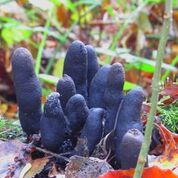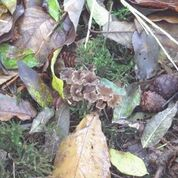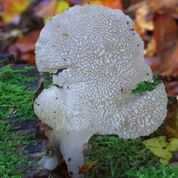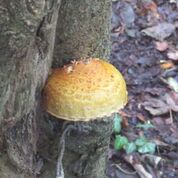Nine of us gathered for this meeting in overcast but otherwise bright, dry and calm conditions. We were in for something of a fungal treat, with over 50 species being recorded in the morning, including several notable finds in this mixed woodland with many sweet chestnut trees in abundant fruit and featuring in the risk assessment. Almost immediately, just outside the entrance of the wood, our way was brightened by a shiny outgrowth of Golden Scalycap (Pholiota aurivella) from an ash tree, shortly to be followed by the blackness of a troop of Dead Man’s Fingers (Xylaria polymorpha). Then, once within the wood itself, a diverse array of variously shaped and coloured fungi presented themselves for our inspection, making our progress slow but rewarding.

Dead Man’s Fingers (© Suk Trippier)

Sinuous Chanterelles (© Suk Trippier)

Some of the more notable finds included a stout specimen of Freckled Brittlegill (Russula illota) whose strong smell of bitter almonds could be detected several metres away; a delicate (and poisonous) toadstool of Green Dapperling (Lepiota grangei); a delightful group of Sinuous Chanterelles (Pseudocraterellus undulatus); a ghostly outcrop of Jelly Tooth (Pseudohydnum gelatinosum) and some well camouflaged Beige Coral (Clavulinopsis umbrinella). More common fungi, like Sulphur Tuft were also abundant.

Golden Scalycap (© Suk Trippier)
Rob Randall and Alan Rayner

Recent Comments